Column
A control that displays its children in a vertical array.
To cause a child control to expand and fill the available vertical space set its expand property.
Examples
Column spacing
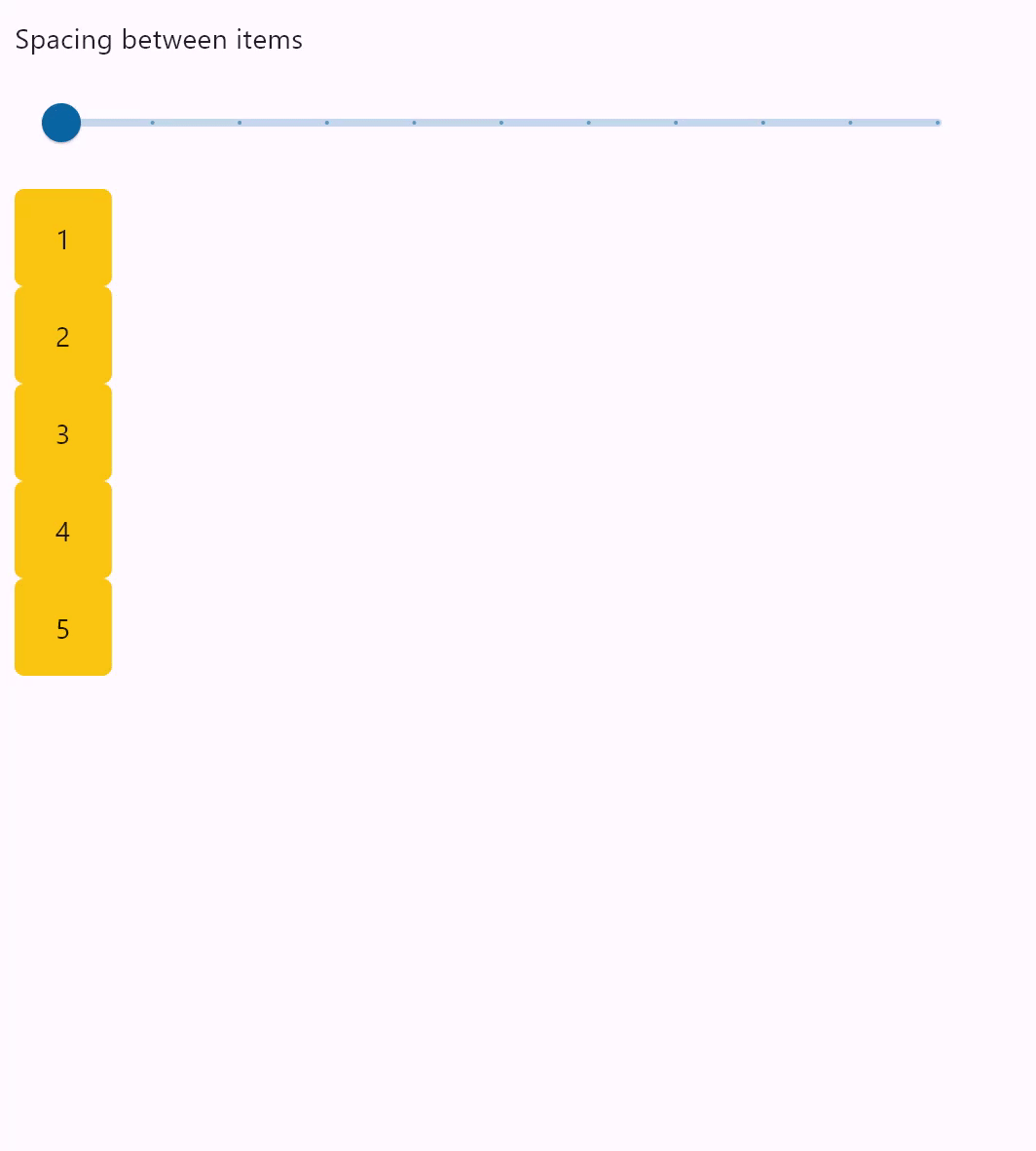
- Python
import flet as ft
def main(page: ft.Page):
def items(count):
items = []
for i in range(1, count + 1):
items.append(
ft.Container(
content=ft.Text(value=str(i)),
alignment=ft.alignment.center,
width=50,
height=50,
bgcolor=ft.colors.AMBER,
border_radius=ft.border_radius.all(5),
)
)
return items
def spacing_slider_change(e):
col.spacing = int(e.control.value)
col.update()
gap_slider = ft.Slider(
min=0,
max=100,
divisions=10,
value=0,
label="{value}",
width=500,
on_change=spacing_slider_change,
)
col = ft.Column(spacing=0, controls=items(5))
page.add(ft.Column([ ft.Text("Spacing between items"), gap_slider]), col)
ft.app(target=main)
Column wrapping
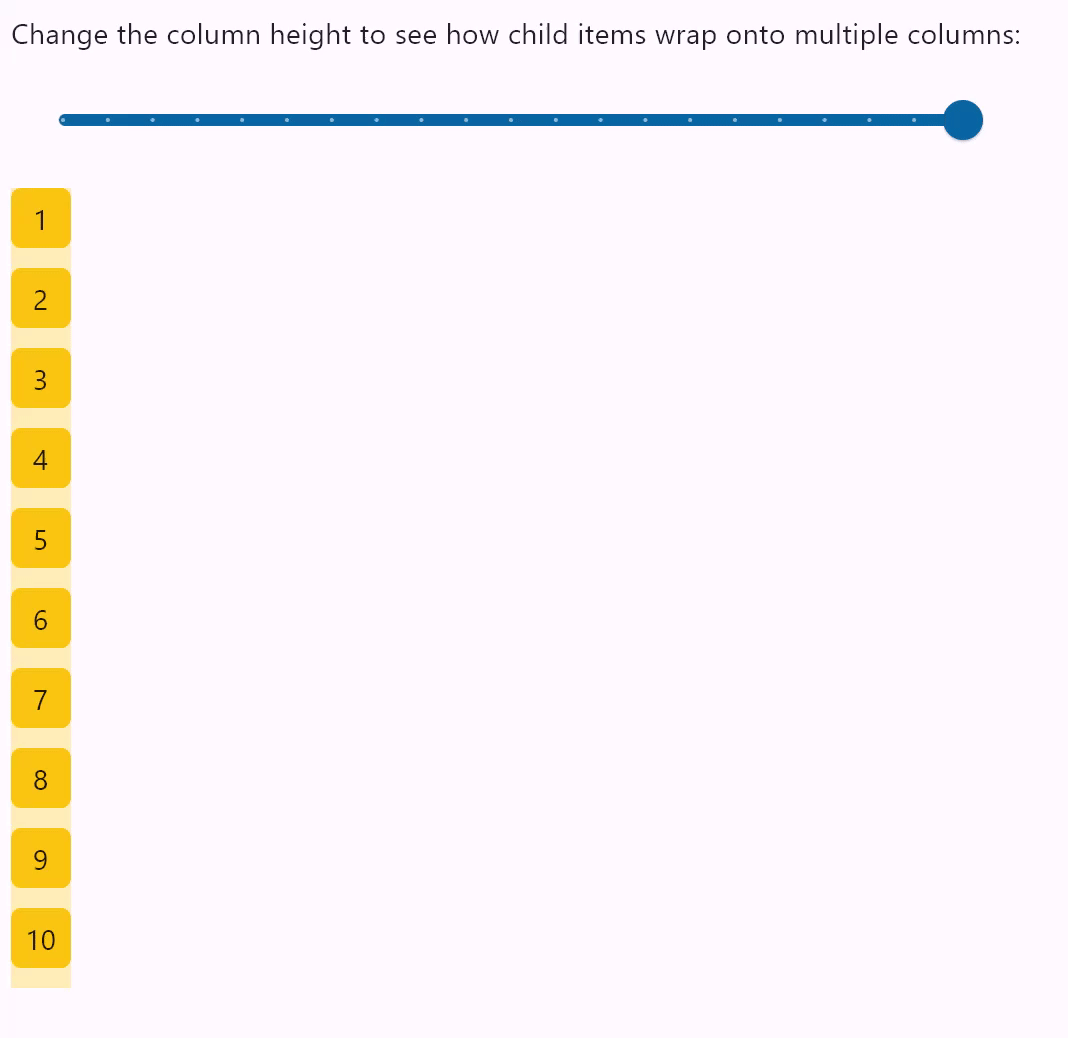
- Python
import flet as ft
HEIGHT = 400
def main(page: ft.Page):
def items(count):
items = []
for i in range(1, count + 1):
items.append(
ft.Container(
content=ft.Text(value=str(i)),
alignment=ft.alignment.center,
width=30,
height=30,
bgcolor=ft.colors.AMBER,
border_radius=ft.border_radius.all(5),
)
)
return items
def slider_change(e):
col.height = float(e.control.value)
col.update()
width_slider = ft.Slider(
min=0,
max=HEIGHT,
divisions=20,
value=HEIGHT,
label="{value}",
width=500,
on_change=slider_change,
)
col = ft.Column(
wrap=True,
spacing=10,
run_spacing=10,
controls=items(10),
height=HEIGHT,
)
page.add(
ft.Column(
[
ft.Text(
"Change the column height to see how child items wrap onto multiple columns:"
),
width_slider,
]
),
ft.Container(content=col, bgcolor=ft.colors.AMBER_100),
)
ft.app(target=main)
Column vertical alignments
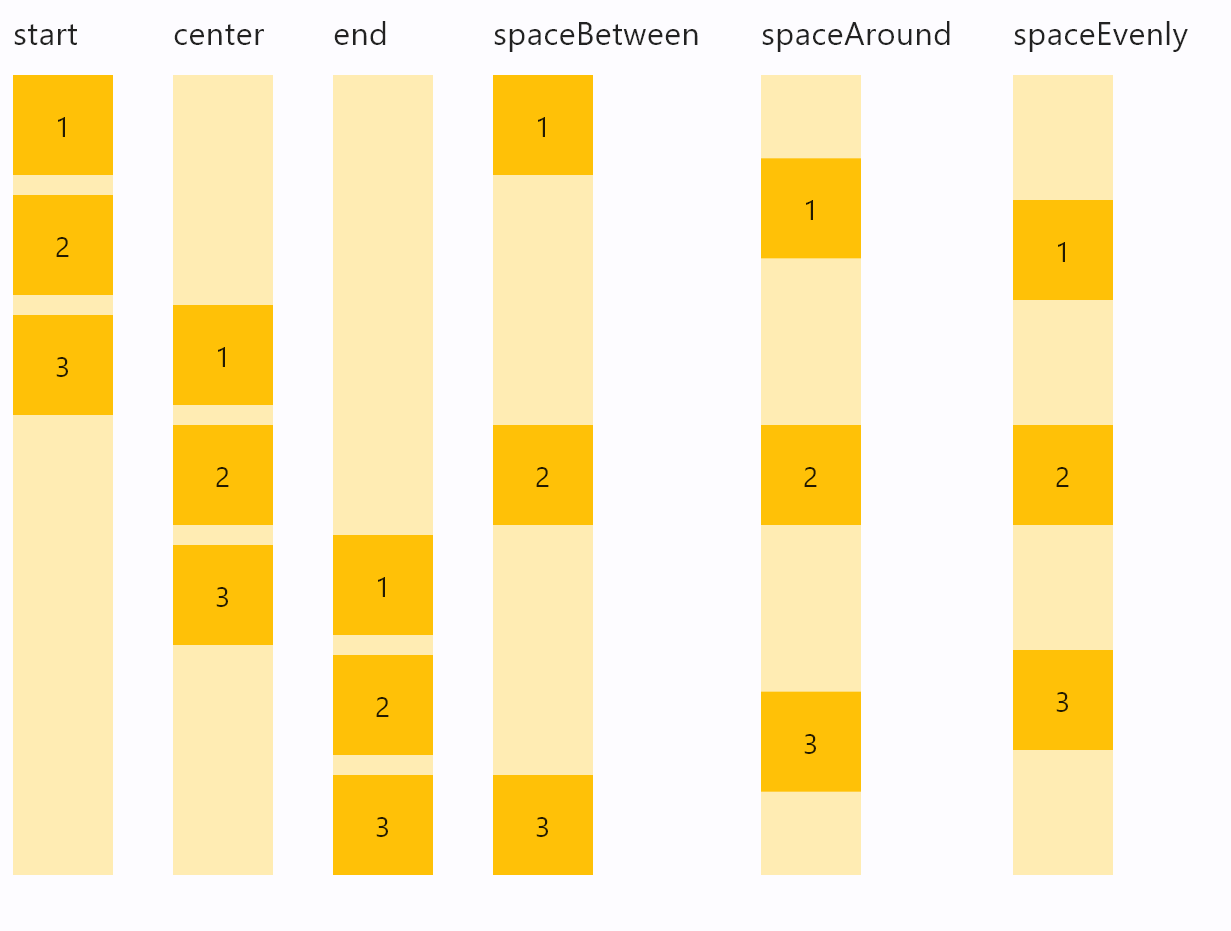
- Python
import flet as ft
def main(page: ft.Page):
def items(count):
items = []
for i in range(1, count + 1):
items.append(
ft.Container(
content=ft.Text(value=str(i)),
alignment=ft.alignment.center,
width=50,
height=50,
bgcolor=ft.colors.AMBER_500,
)
)
return items
def column_with_alignment(align: ft.MainAxisAlignment):
return ft.Column(
[
ft.Text(str(align), size=10),
ft.Container(
content=ft.Column(items(3), alignment=align),
bgcolor=ft.colors.AMBER_100,
height=400,
),
]
)
page.add(
ft.Row(
[
column_with_alignment(ft.MainAxisAlignment.START),
column_with_alignment(ft.MainAxisAlignment.CENTER),
column_with_alignment(ft.MainAxisAlignment.END),
column_with_alignment(ft.MainAxisAlignment.SPACE_BETWEEN),
column_with_alignment(ft.MainAxisAlignment.SPACE_AROUND),
column_with_alignment(ft.MainAxisAlignment.SPACE_EVENLY),
],
spacing=30,
alignment=ft.MainAxisAlignment.START,
)
)
ft.app(target=main)
Column horizontal alignments
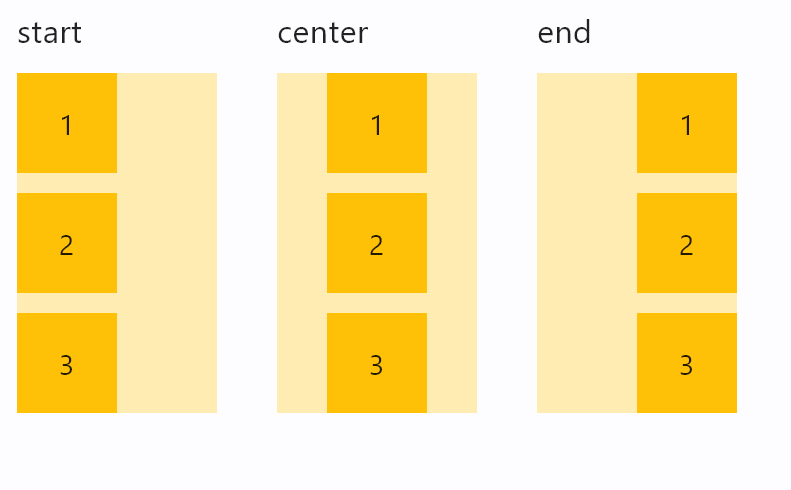
- Python
import flet as ft
def main(page: ft.Page):
def items(count):
items = []
for i in range(1, count + 1):
items.append(
ft.Container(
content=ft.Text(value=str(i)),
alignment=ft.alignment.center,
width=50,
height=50,
bgcolor=ft.colors.AMBER_500,
)
)
return items
def column_with_horiz_alignment(align: ft.CrossAxisAlignment):
return ft.Column(
[
ft.Text(str(align), size=16),
ft.Container(
content=ft.Column(
items(3),
alignment=ft.MainAxisAlignment.START,
horizontal_alignment=align,
),
bgcolor=ft.colors.AMBER_100,
width=100,
),
]
)
page.add(
ft.Row(
[
column_with_horiz_alignment(ft.CrossAxisAlignment.START),
column_with_horiz_alignment(ft.CrossAxisAlignment.CENTER),
column_with_horiz_alignment(ft.CrossAxisAlignment.END),
],
spacing=30,
alignment=ft.MainAxisAlignment.START,
)
)
ft.app(target=main)
Infinite scroll list
The following example demonstrates adding of list items on-the-fly, as user scroll to the bottom, creating the illusion of inifinite list:
import threading
import flet as ft
class State:
i = 0
s = State()
sem = threading.Semaphore()
def main(page: ft.Page):
def on_scroll(e: ft.OnScrollEvent):
if e.pixels >= e.max_scroll_extent - 100:
if sem.acquire(blocking=False):
try:
for i in range(0, 10):
cl.controls.append(ft.Text(f"Text line {s.i}", key=str(s.i)))
s.i += 1
cl.update()
finally:
sem.release()
cl = ft.Column(
spacing=10,
height=200,
width=200,
scroll=ft.ScrollMode.ALWAYS,
on_scroll_interval=0,
on_scroll=on_scroll,
)
for i in range(0, 50):
cl.controls.append(ft.Text(f"Text line {s.i}", key=str(s.i)))
s.i += 1
page.add(ft.Container(cl, border=ft.border.all(1)))
ft.app(main)
Scrolling column programmatically
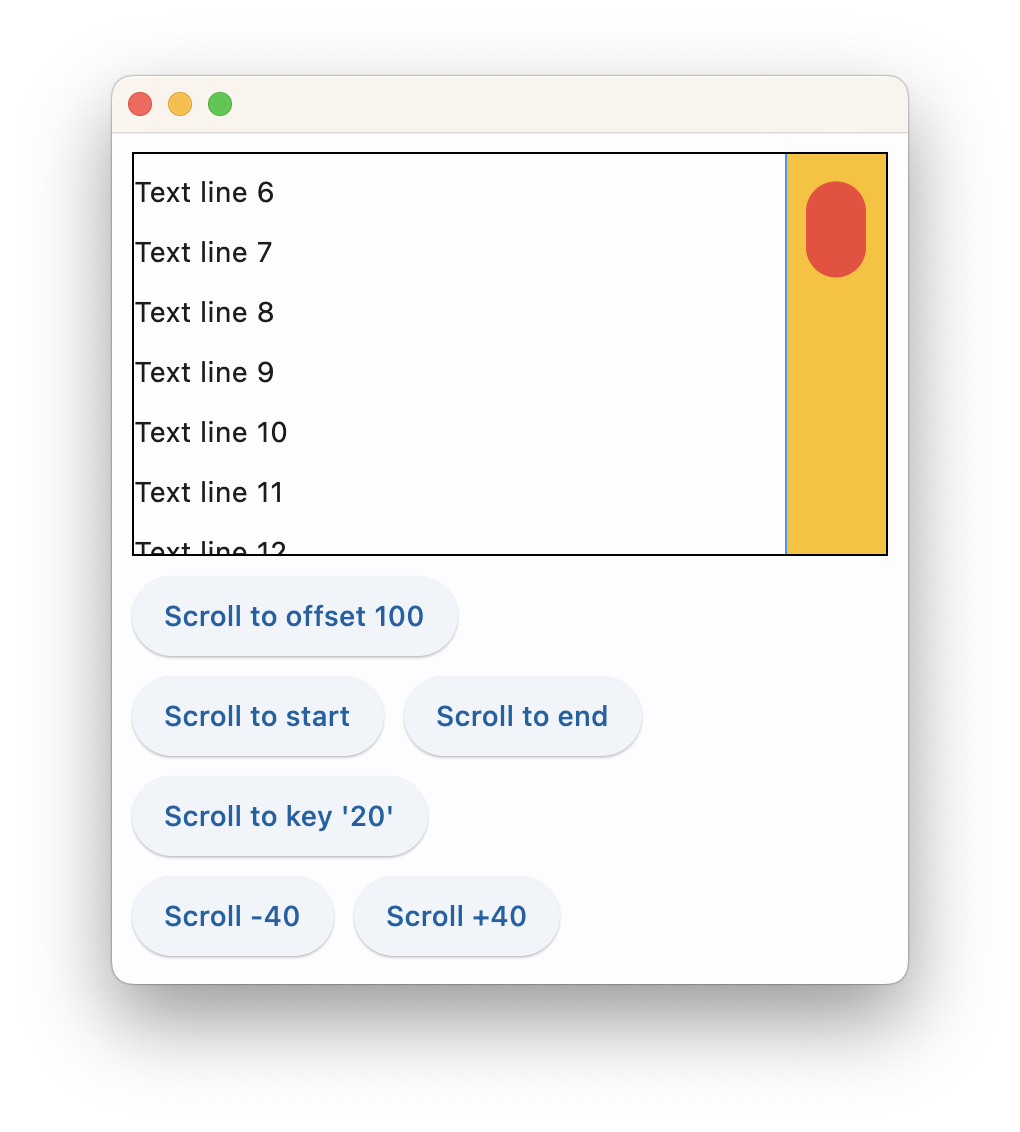
The following example demonstrates various scroll_to() options as well as defines a custom scrollbar theme:
import flet as ft
def main(page: ft.Page):
page.theme = ft.Theme(
scrollbar_theme=ft.ScrollbarTheme(
track_color={
ft.MaterialState.HOVERED: ft.colors.AMBER,
ft.MaterialState.DEFAULT: ft.colors.TRANSPARENT,
},
track_visibility=True,
track_border_color=ft.colors.BLUE,
thumb_visibility=True,
thumb_color={
ft.MaterialState.HOVERED: ft.colors.RED,
ft.MaterialState.DEFAULT: ft.colors.GREY_300,
},
thickness=30,
radius=15,
main_axis_margin=5,
cross_axis_margin=10,
# interactive=False,
)
)
cl = ft.Column(
spacing=10,
height=200,
width=float("inf"),
scroll=ft.ScrollMode.ALWAYS,
)
for i in range(0, 100):
cl.controls.append(ft.Text(f"Text line {i}", key=str(i)))
def scroll_to_offset(e):
cl.scroll_to(offset=100, duration=1000)
def scroll_to_start(e):
cl.scroll_to(offset=0, duration=1000)
def scroll_to_end(e):
cl.scroll_to(offset=-1, duration=2000, curve=ft.AnimationCurve.EASE_IN_OUT)
def scroll_to_key(e):
cl.scroll_to(key="20", duration=1000)
def scroll_to_delta(e):
cl.scroll_to(delta=40, duration=200)
def scroll_to_minus_delta(e):
cl.scroll_to(delta=-40, duration=200)
page.add(
ft.Container(cl, border=ft.border.all(1)),
ft.ElevatedButton("Scroll to offset 100", on_click=scroll_to_offset),
ft.Row(
[
ft.ElevatedButton("Scroll to start", on_click=scroll_to_start),
ft.ElevatedButton("Scroll to end", on_click=scroll_to_end),
]
),
ft.ElevatedButton("Scroll to key '20'", on_click=scroll_to_key),
ft.Row(
[
ft.ElevatedButton("Scroll -40", on_click=scroll_to_minus_delta),
ft.ElevatedButton("Scroll +40", on_click=scroll_to_delta),
]
),
)
ft.app(main)
Properties
alignment
How the child Controls should be placed vertically.
Property value is MainAxisAlignment enum with the following values:
START(default)ENDCENTERSPACE_BETWEENSPACE_AROUNDSPACE_EVENLY
auto_scroll
True if scrollbar should automatically move its position to the end when children updated. Must be False for scroll_to() method to work.
controls
A list of Controls to display inside the Column.
horizontal_alignment
How the child Controls should be placed horizontally.
Property value is CrossAxisAlignment enum with the following values:
START(default)CENTERENDSTRETCHBASELINE
on_scroll_interval
Throttling in milliseconds for on_scroll event. Default is 10.
scroll
Enables a vertical scrolling for the Column to prevent its content overflow.
Property value is an optional ScrollMode enum with None as default.
Supported values:
None(default) - the column is non-scrollable and its content could overflow.AUTO- scrolling is enabled and scroll bar is only shown when scrolling occurs.ADAPTIVE- scrolling is enabled and scroll bar is always shown when running app as web or desktop.ALWAYS- scrolling is enabled and scroll bar is always shown.HIDDEN- scrolling is enabled, but scroll bar is always hidden.
spacing
Spacing between controls in a Column. Default value is 10 virtual pixels. Spacing is applied only when alignment is set to start, end or center.
run_spacing
Spacing between runs when wrap=True. Default value is 10.
tight
Specifies how much space should be occupied vertically. Default is False - allocate all space to children.
wrap
When set to True the Column will put child controls into additional columns (runs) if they don't fit a single column.
Methods
scroll_to(offset, delta, key, duration, curve)
Moves scroll position to either absolute offset, relative delta or jump to the control with specified key.
offset is an abosulte value between minimum and maximum extents of a scrollable control, for example:
products.scroll_to(offset=100, duration=1000)
offset could be a negative to scroll from the end of a scrollable. For example, to scroll to the very end:
products.scroll_to(offset=-1, duration=1000)
delta allows moving scroll relatively to the current position. Use positive delta to scroll forward and negative delta to scroll backward. For example, to move scroll on 50 pixels forward:
products.scroll_to(delta=50)
key allows moving scroll position to a control with specified key. Most of Flet controls have key property which is translated to Flutter as "global key". key must be unique for the entire page/view. For example:
import flet as ft
def main(page: ft.Page):
cl = ft.Column(
spacing=10,
height=200,
width=200,
scroll=ft.ScrollMode.ALWAYS,
)
for i in range(0, 50):
cl.controls.append(ft.Text(f"Text line {i}", key=str(i)))
def scroll_to_key(e):
cl.scroll_to(key="20", duration=1000)
page.add(
ft.Container(cl, border=ft.border.all(1)),
ft.ElevatedButton("Scroll to key '20'", on_click=scroll_to_key),
)
ft.app(main)
scroll_to() method won't work with ListView and GridView controls building their items dynamically.
duration is scrolling animation duration in milliseconds. Defaults to 0 - no animation.
curve configures animation curve. Defaults to ft.AnimationCurve.EASE.
Events
on_scroll
Fires when scroll position is changed by a user.
Event handler argument is an instance of ft.OnScrollEvent class with the following properties:
event_type(str) - type of the scroll event:start- control has started scrolling;update- control has changed its scroll position;end- control has stopped scrolling;user- user has changed the direction in which they are scrolling;over- control has not changed its scroll position because the change would have caused its scroll position to go outside its scroll bounds;
pixels(float) - The current scroll position, in logical pixels.min_scroll_extent(float) - The minimum in-range value forpixels.max_scroll_extent(float) - The maximum in-range value forpixels.viewport_dimension(float) - The extent of the viewport.scroll_delta(float) - The distance by which the scrollable was scrolled, in logical pixels. Set forupdateevents only.direction(str) - The direction in which the user is scrolling:idle,forward,reverse. Set foruserevents only.overscroll(float) - The number of logical pixels that the scrollable avoided scrolling. Set foroverevents only.velocity(float) - The velocity at which the ScrollPosition was changing when this overscroll happened. Set foroverevents only.
Expanding children
When a child Control is placed into a Column you can "expand" it to fill the available space. Every Control has expand property that can have either a boolean value (True - expand control to fill all available space) or an integer - an "expand factor" specifying how to divide a free space with other expanded child controls. For example, this code creates a column with a Container taking all available space and a Text control at the bottom serving as a status bar:
r = ft.Column([
ft.Container(expand=True, content=ft.Text("Here is search results")),
ft.Text("Records found: 10")
])
The following example with numeric expand factors creates a Column with 3 containers in it and having heights of 20% (1/5), 60% (3/5) and 20% (1/5) respectively:
r = ft.Column([
ft.Container(expand=1, content=ft.Text("Header")),
ft.Container(expand=3, content=ft.Text("Body")),
ft.Container(expand=1, content=ft.Text("Footer"))
])
In general, the resulting height of a child in percents is calculated as expand / sum(all expands) * 100%.